by Winding Pathways | Dec 7, 2023 | (Sub)Urban Homesteading, Birds, Nature
Why do Birds Fly Into Windows?
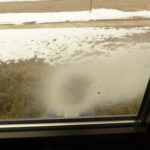
The spray makes the window opaque.
Windows, deadly for birds. According to the National Audubon Society, about one billion birds are killed every year when they crash into windows. About half collide with low commercial building windows with the rest crashing into home windows. Surprisingly few seem to crash into the high windows of skyscrapers.
Birds fly into windows because they just don’t see them and assume they’re about to zip through safe soft air. Sometimes they may see reflections of vegetation behind them and think they are zooming to a convenient perch.
How to Help a Bird
When Rich was director of the Indian Creek Nature Center, he’d often get calls from upset people who had just found a quivering bird beneath their window. In his experience one of two outcomes is likely. Either the bird will soon die or it will fully recover and fly off. He suggests leaving the bird alone for at least an hour unless it’s likely to fall prey to a hungry neighborhood cat. In that case, it is probably best to gently place it in a cardboard box to give it a chance to recover…or die.
Unfortunately, there’s no effective first-aid technique to reverse death. Hopefully, the bird will soon recover and speed away. If not, a respectful burial is in order.
Tips
Here are some tips from the Portland, Oregon, Audubon Chapter of the National Audubon Society for reducing window collisions:
- Place bird feeders away from large windows.
- Avoid putting house plants immediately inside windows. Birds may see them and attempt to fly to a perch.
- Put stickers/decals on the outside of windows. (Note: Many sources recommend these. Stickers can be bought online or at bird-feeding stores……but we, at Winding Pathways, have not found them very effective.
- Stretch netting across the outside of the window to physically keep birds from crashing. We’ve found this best on windows that experience frequent bird collisions.
- Put colorful tape on the outside of the windows.
- Douse outside lights. Come sundown our nation is way over-lit. Lights block viewing the magnificent night sky while often disorienting migrating birds.
We Can Help
Songbirds face many challenges in our modern world. They crash into windows, hit poles, get gobbled up by house cats, and are confused by electric lights. They need all the human help they can get to stay alive and healthy.
by Winding Pathways | Nov 16, 2023 | Nature, Travel/Columns
Lynyrd Skynyrd Tribute
“Sweet Home Alabama” by Lynyrd Skynyrd is a “heartfelt tribute to the state of Alabama.” Adopted by Alabama tourism as its slogan the “catchy” phrase indeed speaks to the variety and comfort of this truly Southern Hospitality state.
On a hot and muggy September trip to the deep South, we experienced Alabama hospitality and diversity from north to south.
Surprising Diversity
The northern third of Alabama is rugged where the Appalachian Mountains swing in from the northeast and finger down southwest toward the center of the state. The Tennessee River flows from Knoxville, TN, then cuts northwest through Huntsville and Decatur and on into the Tennessee Valley Authority. It’s wet there and tent camping is an adventure when the waters run high. We quickly learned that most of the waterways flow south and spill eventually into the Gulf. Planning our crossings was important because there are limited bridges from west to east.
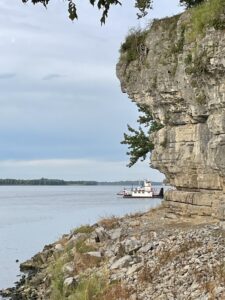
Quick way to cross the Ohio
Further north we did ferry across the Ohio at Cave in Rock, IL. This working ferry gets local and distance travelers across the broad river. The sounds of the ferry clanging and moaning of chains and engines at night recalled Jurassic Park! Then we wound our way through Kentucky and Tennessee to Alabama following parts of the Natchez Trace and the Trail of Tears.
Geologically, the ancient Appalachians of northern Alabama boast caverns, natural bridges, and tumbling waterways with falls. Cooler mountain air and vistas delight weary travelers’ eyes.
Birders find diverse birding from the endangered Red-cockaded Woodpecker that thrives in mature pine forests to the Bald Eagles that seem to soar everywhere nonplussed by humans. Nearer the coast migrating birds rest from their long flight over the Gulf. The State promotes varied birding trails.
Culturally, The Poarch Creek Indians hold Alabama sacred and are the only federally recognized Indian Tribe in the state. The Helen Keller home in Sheffield and Huntsville’s U.S. Space and Rocket Center are great stops.
This unusual phrase refers not to martial arts but to fertile calcareous soils that span central Alabama. Here, farming in plantations dominated. This region is also where the Civil Rights movement of the ‘60s. Montgomery hosts the new Legacy Museum that powerfully retells the story of kidnapped Africans who became slaves on plantations and the unjust, centuries-long suppression and incarceration of people. Along with The National Memorial for Peace and Justice, this important, interactive museum holds accountable past injustices and opens the door for reconciliation and cultural change where we ALL can be better people.
-
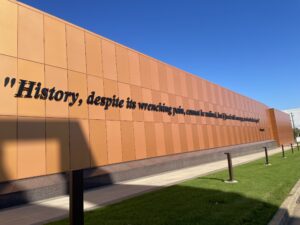
-
A sober and important museum of history.
-

-
Blend of new and old
The Coastal Shores
The drive through large swaths of timber-harvested pine forests revealed a source of the nation’s telephone poles. So, thank Alabama’s logging industry the next time you pass a pole. Our destination was Gulf Shores State Park and Lodge where we explored for three days. The Lodge is LEED certified and surrounding modern “cabins” and RV camping accommodate most budgets. How smart of the state to get this piece of Gulf land. It is one of the few areas not privately developed and with views of the Gulf waters. With miles of bicycle trails, fresh, brackish, and salt-water areas, and white sugar sand beaches, it is totally enjoyable. The habitat changes in a short distance depending on elevation (yes there is elevation along the coast) and proximity to the Gulf. We bicycled past freshwater ponds, palmetto areas, oak knobs, and back to beach habitat.
Lots for most people to take in. Our favorite was walking after dark along the shore looking for the ghost crabs. Herons stalked nearby, also on the hunt. Dawn found us sitting quietly along with others watching the sun rise over the Gulf. Each day crews set out and took in beach chairs and umbrellas. Flags flutter in strategic places alerting visitors to water conditions. During our stay, small yellow flags rippled in stiff winds. Rip currents are a thing to pay attention to.
-
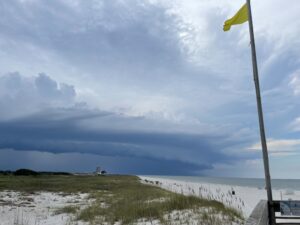
-
Weather changes rapidly along the Gulf.
-
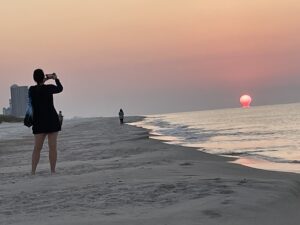
-
Quiet time at sunrise in Sweet Home Alabama
-
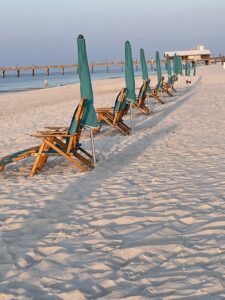
-
Ready for beach goers.
Rich took in a day fishing trip out of sight of land learning more about Gulf waters, sea bed, and the fishing industry. Marion took in oyster harvesting. Owners of Admiral Shellfish and Navy Cove shared the aquaculture techniques to raise oysters from pinpoint size to eating size in a matter of months. In northern waters, it’s years before edible oysters can be harvested. We both enjoyed several meals of oysters – who got the raw end of the deal!
-
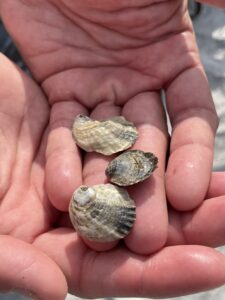
-
Gulf oysters
-
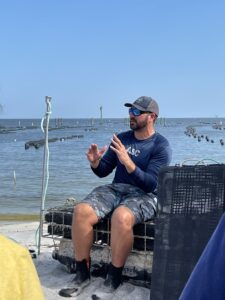
-
Protected waters make excellent habitat for oysters.
Lodging & FOOD!
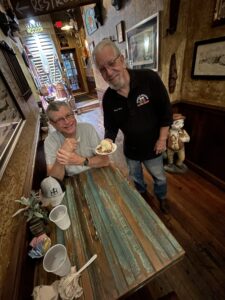
Uncle Mick’s Cajun old town Prattville is THE place to eat Southern.
We can’t say enough about Sweet Home Alabama hospitality and food. The front desk staff at the Hampton Inn and Suites, Prattville, AL, are some of the most friendly, efficient, and kind service workers we have ever met. They guided us to Uncle Mick’s Cajun just down the road in old town Prattville. The unique and tasty dishes and personal touches by the owner made the meal memorable. Staff kept dishing up small portions of truly Southern food for us to try and then loaded on our choices. Uncle Mick himself visited and drawled, “Would you like the pecan pie warmed up?” Well, yes. “How about a scoop of our local vanilla ice cream?” Well, yes. “And we’ll pour over warm bourbon sauce. If you’d like.” Well, YES! All at no extra charge. Amazing!
At Gulf Shores, the Flying Harpoon is truly local. Unpretentious, funky, and busy! Eating our po boys, and shrimp baskets, and sipping a local brew we chatted with servers and residents. Down the road tourists dined at the “recommended” upscale restaurants.
One of our most curious adventures was the luxury RV water park Tropic Falls at OWA. Not much natural there, but a great time watching huge buckets fill with water and splash down soaking nearby visitors. It was hot so that was fine! Tropical falls and dizzying roller coaster rides were two hits along with mermaids serving beverages and food. Quite the place. Be ready to spend money.
Back up through pine forests, skirting rivers, crossing the Ohio and Mississippi Rivers, and on into familiar Midwest terrain. We carry memories and stories with us.
by Winding Pathways | Nov 9, 2023 | (Sub)Urban Homesteading, Mammals, Nature
Update on Furless Tailed Squirrels
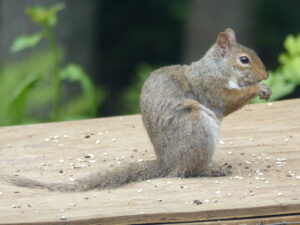
Even in winter, the squirrels’ fur looks healthy…except for their tails.
Two winters ago, we noticed squirrels with nearly furless tails visiting our bird feeders. Our blog about them on Winding Pathways brought hundreds of visitors. Some from other countries! Apparently, we weren’t the only people seeing these hapless animals.
Last winter we had almost no squirrels in the yard. We wonder if the malady that caused them to lose tail fur might have knocked their population way back.
This fall we’re seeing plenty of both fox and gray squirrels in our yard. Their populations have rebounded. And, they have long, furry tails! Squirrels make us happy. While many people don’t like them gobbling seeds at the feeder, we are OK with that and find them as fascinating and fun as cardinals, chickadees, and goldfinches.
Squirrels and the Derecho
Now three years since the disastrous derecho that felled thousands of trees in the Eastern Iowa area, we’re seeing the vital work squirrels do. In the wake of the storm, people planted thousands of trees. Then came three drought years. The National Weather Service placed Cedar Rapids into its exceptional drought category in 2023.
The drought killed many human-planted trees but the ones planted by squirrels are doing just fine. Thanks to them, baby hickories, walnuts, and oaks are poking through the soil in nearby woodlands and our yard.
This fall we’ve watched squirrels carry acorns and walnuts across the yard, dig frantically, and bury their treasure. These enthusiastic gatherers and diggers plan to return during winter’s lean months to retrieve dinner from underground storage. Fortunately, squirrels bury more nuts than they’ll ever need. Unfortunately for them, some of the furry hoarders die with their hidden hoard untouched to sprout in the spring. Squirrels are master tree planters.
-
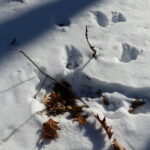
-
Squirrels at work.
-
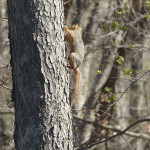
-
What happens when a squirrel falls?
-
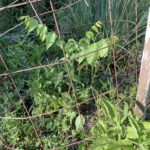
-
This squirrel planted walnut seedling sprouted just this year in spite of the drought.
American Ninjas in the Yard
An oak and a walnut live about 150 feet south of our back deck. Acorns and walnuts are epicurean squirrel delights, and our trees attract the furry acrobats. Squirrels like to use treetops as highways, jumping from one to the next. Our oak and walnut presented them with a problem. There is a several-foot gap between their branch tips. We are fascinated watching the squirrels make the long leap from twig to twig, sometimes leaping up to reach a branch on another tree, often while clutching a nut in its teeth. Their athleticism is astounding. So is their courage.
Squirrels fall. Twice we’ve seen one lose its grip and drop from the top of enormous trees. Both times the furry animals spread eagle their legs and tails while descending and hit the ground with a thump. They are shaken, rest, and then scamper off. A fall that would instantly kill a person, is hardly phased by the squirrels.
This winter we’ll again welcome squirrels to our feeders. They can dine on whole or cracked corn and cobs. We are assured of entertainment with their romps, athleticism and enthusiasm.
-
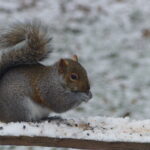
-
Squirrel tails have many uses.
-
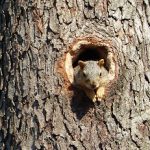
-
It’s a long way down, Mom.
-
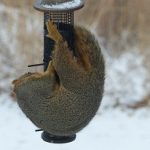
-
Squirrels wolf down seed meant for birds.
by Winding Pathways | Oct 26, 2023 | (Sub)Urban Homesteading, Garden/Yard, Nature, Trees
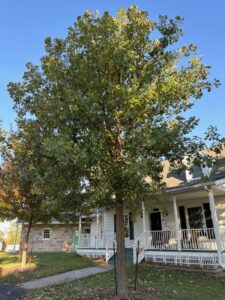
Magnet bur oak in front yard
We didn’t intend to create a magnet when we planted a skinny bur oak in our front yard 13 years ago.
It created a startling experience one October evening when Marion went to the porch to check the weather. A large furry form dropped from the nearby tree and scurried away in the gathering darkness. A woodchuck? Not likely. They work the day shift. Later we caught the mystery animal in the bean of a flashlight as it returned to the magnet tree. A husky raccoon that again retreated in haste when it saw us.
Over the next several days we watched squirrels and woodchucks forage on the acorns. At dusk bucks and does with yearlings eagerly, yet watchfully, gobbled up acorns. In between, turkeys wandered by to forage. Blue jays dropped out of the tree onto the ground and carried off husky acorns to store for winter.
Why Oaks Attract Wildlife
Our October oak was a perfect magnet. While most area oaks were acorn-bare, our youthful front yard tree was loaded with them. They were huge, sweet, and free of the weevils that often consume acorns before exiting through tiny holes.
Blue jays, wild turkeys, woodchucks, raccoons, squirrels, and deer consider October acorns prime carbohydrate-loaded food. When few oaks, scattered around, bear a heavy crop, wild animals beeline to those loaded with nuts. That’s why our tree was a magnet drawing in a stream of wildlife until every acorn was consumed.
-
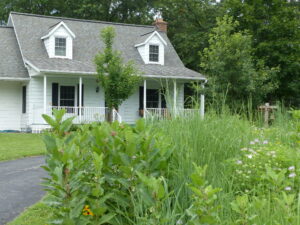
-
Small oak and maple.
-
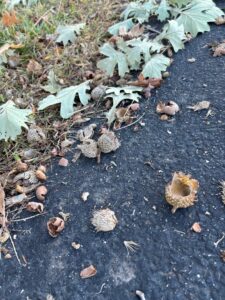
-
Prolific Bur Oak acorns
-
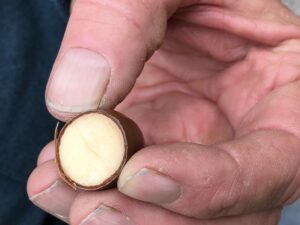
-
White oak acorns have lower tannic acid.
White oak types have leaves with rounded lobes. These include white, bur, and swamp white oaks. Their big acorns are low in tannic acid and are a prized animal and human food. Most trees only bear a heavy crop every few years with acorns that sprout almost as soon as they hit the ground. If not eaten soon weevils find them.
Black oak types have leaves with pointed lobes. Their acorns are loaded with bitter tannin. Often wild animals only feast on them after nearby sweeter white oak-type acorns have all been eaten. Black oak-type acorns wait until next spring to sprout. Perhaps their tannic acid helps them remain uneaten until they sprout months after falling from the tree.
Optimal Places to Plant Oaks
When planted in an ideal location with full sun and rich soil, an oak will begin producing acorns when it’s seven to ten years old. Our front yard tree had a light crop the past few years, but when it reached its 13th year it was loaded with nuts. It was a true magnet that lured wildlife in from far and wide. We enjoyed watching many animals dine on acorns produced by a tree we planted.
by Winding Pathways | Oct 19, 2023 | Nature, Wonderment
Tattoos to You
Recently we have noted people’s tattoos. How fun and meaningful they are. That has not always been the case. Throughout cultures, in eras past, tattoos have been both shunned and venerated. Dating from 5,000 years ago, in Japanese cultures, tatts identified gangs and slaves. Similar to today in different regions of the world.
On the other hand, ancient Egyptian themes centered on fertility and protection in childbirth, the arts and dance.
European Influence
The Picts and Celts of Scotland and Ireland sported fierce body art that duly impressed the Roman soldiers who admired the virile images and feared the fierce warriors.
Europe’s relation with tattoos has been influenced by the several other cultures that invaded over centuries. Again, its fortunes rose and fell as cultures adopted for signs of wealth or as ways to identify slaves. The sordid history of tattoos associated with Nazis soured Americans on tattoos until more recent years. Today, people of all ages and social statuses sport tattoos. Most have special meaning to the person displaying them.
Here are a few we’ve chatted with people about.
-

-
Each a story
-

-
Loving sentiment
-

-
Mountains and Vases
Kate started the quest for stories at the recent Outdoor Writers Association of America conference at Gulf Shores, Alabama. When she travels she researches tattoo artists in the cities and countries she plans to visit, scans their electronic portfolios, checks their credentials, and connects with them. From standard to fine lines, and from nature to sayings by loved ones, each tells stories important to her and is a memento of trips.
-

-
Rising
-
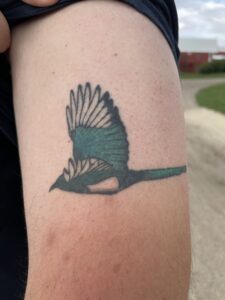
-
Taking flight
Nature themes are popular. The phoenix theme rising again and a nod to the tattoo owner’s children and the magpie is often interpreted as a sign of good luck.
-

-
Fertility and parenting
-

-

-
Mermaid with tattoo.
Egyptian themes have resonated with librarians and “mermaids!” Harthor, the Goddess of fertility, love, and protection in birth & parenting; the “good luck” scarab beetle; and cats, are always venerated in Egyptian mythology.
-

-
All ages enjoy tattoos
-

-
Power Puffs have super powers.
-
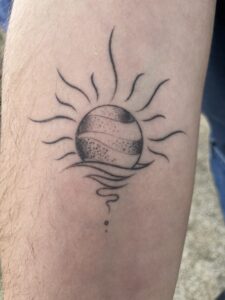
-
This tattoos honors siblings and travel.
-

-
Kansas motto tattoo.
Triangles connect family, Buttercup, of the Powerpuff Girls, the animated TV series from the 1990s inspires humor and superpowers. The State of Kansas motto shines brightly on this man’s arm.
Sailors popularized tattoos in the 1700s when returning from long voyages, especially from the Pacific Islands, sporting elaborate tatts. Of course, soon, royalty had to follow. Purportedly even Winston Churchill and his mother had tattoos.
The popularity of tattoos is on the rise with personalized images and sayings in full display.
by Winding Pathways | Sep 21, 2023 | (Sub)Urban Homesteading, Flowers/Grasses, Foraging, Nature
By September our thoughts and actions turn to autumn – fall sports, raking leaves, and cozy weekend campfires. For wildlife, especially pollinators late summer and early autumn are critical times to gather nourishment for migrations or hunkering down for winter’s scarcity.
-
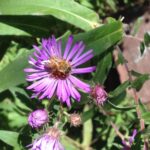
-
Foraging
-
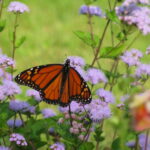
-
Feeding on nectar.
-
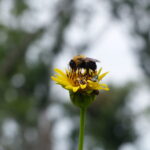
-
Insects find flowers.
-
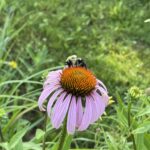
-
Busy at work.
On our daily walks, often in the early morning to avoid late-season heat, we notice and appreciate late bloomers and nut abundance. Nectar is an important food supply for pollinators who busily forage among flowers. When the weather cools, pollinators are out later in the day as the sun warms the air. Remember, there is a “night shift” of pollinators, too, who need flowers to feed from.
Here are some late-blooming flowers we have seen on walks or that we nurture in our yard.
-
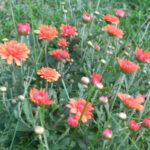
-
cultivated flowers work, too.
-
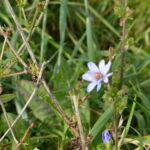
-
Roadside blooms are important.
-
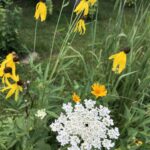
-
Color contrast.
-
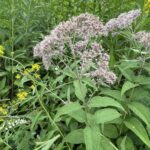
-
Some flowers prefer low lying areas to grow.









































